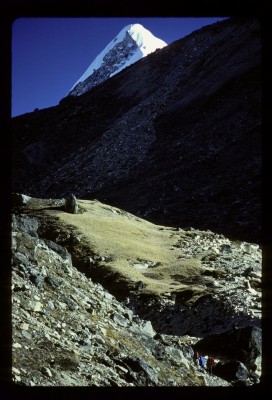Franz Liszt: Transcendental Etude No. 11, “Harmonies du Soir,” 1826; complicated 1838; simplified 1851.
Listen to the author reading the text
 When he wrote the Transcendental Etudes, Liszt was just fifteen. It was 1827. His father had just died, having squandered the all the money Liszt had spent five years building up since he was ten. Liszt was so poor he had to sell his piano. He lived alone on the rue Montholon in Paris, surrounded by books. He had become so inner he could not speak in company, as happens when you spend your whole time reading. He had lost his girlfriend, the daughter of the French Minister of Commerce, who had forbidden his daughter to date an impoverished musician. Liszt was so depressed, his obituary was published. At least we have that in common. So the roots of the Etudes are steeped in poverty, melancholy, and presumed death, written in homage to a piano he did not even have. Glenn Gould always felt that art needs solitude to flourish, as was the case with Thomas Mann.
When he wrote the Transcendental Etudes, Liszt was just fifteen. It was 1827. His father had just died, having squandered the all the money Liszt had spent five years building up since he was ten. Liszt was so poor he had to sell his piano. He lived alone on the rue Montholon in Paris, surrounded by books. He had become so inner he could not speak in company, as happens when you spend your whole time reading. He had lost his girlfriend, the daughter of the French Minister of Commerce, who had forbidden his daughter to date an impoverished musician. Liszt was so depressed, his obituary was published. At least we have that in common. So the roots of the Etudes are steeped in poverty, melancholy, and presumed death, written in homage to a piano he did not even have. Glenn Gould always felt that art needs solitude to flourish, as was the case with Thomas Mann.
As James Huneker said in his book, Liszt, when Liszt rewrote the Etudes in 1839, he wrote the history of the piano during the last half of the nineteenth century. Everything the piano meant to its composers and its audience, everything the piano could do, was thrown into the mix. With it, Liszt wrote his own identity. The sunsets of painters, the fight for Polish independence, the stillness of preindustrial meadows, all are there. History is not just the machinations of ministers, but the emotions that spring in any given year from a summer sky.
Amy Fay, Liszt’s American student, a schoolgirl in Germany in the 1870’s, has left us one of the most realistic portraits of Liszt’s playing:
It was a hot afternoon and the clouds had been gathering for a storm . . . a low growl of thunder was heard muttering in the distance. “Ah,” said Liszt, who was standing at the window, “a fitting accompaniment.” If only Liszt had played Beethoven’s Appassionata sonata himself the whole thing would have been like a poem. But he walked up and down and forced himself to listen, though he could scarcely bear it. A few times he pushed the student aside and played a few bars himself, and we saw the passion leap into his face like a glare of sheet lightning. Anything so magnificent as it was, the little that he did play, and the startling individuality of his conception, I never heard or imagined.
But here is the great pianist and teacher, Siloti, equally impressed with Liszt’s tone:
[T]he piano was worn out, unequal and discordant. Liszt had only played the opening triplets of Beethoven’s Moonlight Sonata however when I felt as if the room no longer held me and when, after the first four bars, the G sharp came in the right hand, I was completely carried away. Not that he accented this G sharp; it was simply that he gave it an entirely new sound, which even now, after twenty-seven years, I can hear distinctly.
It was Liszt’s sound, not his speed, which fascinated everyone. As the musicologist E. J. Dent wrote:
. . . minor pianists turn [the greater works of Liszt] into mere displays of virtuosity because their technique is inadequate for anything beyond that. . . .
Heine confirmed that when Liszt played, “the piano vanishes, and music appears.”
 Liszt’s technique eventually advanced to the point where he no longer cared about it. “My dear, I don’t care how fast you can play the octaves,” he told a pupil. In 1851 he revised his octaves away from sheer technique into the version that is performed today. Nevertheless, Liszt was said to be able to hit two notes many octaves apart with one hand, so fast that it sounded as if both notes were hit at exactly the same time, so simplicity, in his case, is a relative term. This ability to leap great distances without sacrificing delicacy or accuracy of intonation is one of the many challenges of the piece, as well as anyone’s mission in life, namely, to bridge ages and places, composers and classes, without losing our own music.
Liszt’s technique eventually advanced to the point where he no longer cared about it. “My dear, I don’t care how fast you can play the octaves,” he told a pupil. In 1851 he revised his octaves away from sheer technique into the version that is performed today. Nevertheless, Liszt was said to be able to hit two notes many octaves apart with one hand, so fast that it sounded as if both notes were hit at exactly the same time, so simplicity, in his case, is a relative term. This ability to leap great distances without sacrificing delicacy or accuracy of intonation is one of the many challenges of the piece, as well as anyone’s mission in life, namely, to bridge ages and places, composers and classes, without losing our own music.
In fact, nothing beautiful is really difficult, because there is so much motivation to learn it. The Godowsky vivisections of Chopin’s Etudes are difficult, because they complicate for the sake of complication. Any virtuosic showpiece is as suspect: febrile, spiderlike skitterings about the web are rarely as beautiful as the dew suspended delicately on it.
Liszt’s complexities are simply multiple simplicities. The great rolling chords, the Harmonies of the title, are in fact three melodies played by one hand, so that the middle melody, for example, must somehow be made to tie into the middle note of the next rolled chord, as if three singers were fighting for prominence simultaneously: hopefully, no one wins.
The colors of evening darken in their husky D flat registers, and the fuliginous sky gathers its penumbra of heliotropes, to put it the way writers of the day would have— that is, the sunset thickens and grows, as the muumuus and murmurs of willows and poplars grow into a great coloristic grove of sound. This is sound imitating sight.
Whether or not Liszt is thinking of clouds bloodying or leaves rouging, skylong rays of gold linking all the clouds, or yellows deepening to rococo velours in the distorted lead of a monastery window, the pianist must have something in mind other than the notes and half-notes, the haves and have-nots, the nots and half-nots.
 Only then is technique transcended by thought, and technique is what the Transcendental Etudes transcend. Having played in Khatmandu, just before the roof collapsed, killing a servant who was dusting the piano, but just missing the more culpable pianist, who has always felt he was the point of that architectural criticism and thus falsely spared at the expense of a blameless boy, such aleatory incidents remind me that music is not just a Western toy, it is equally a prayer flag on which to ascend into this swirling Himalayan vapor, into the numina, the spirits of the sky, the icons which lead us to their palisades and palimpsests, to their cloudy tents and pentimentos, to unearth in the sky states hiding in statues, traps in tropes, hopes in notes, the point of it being to unearth the earth, or at least free us, and that dusting boy, from it.
Only then is technique transcended by thought, and technique is what the Transcendental Etudes transcend. Having played in Khatmandu, just before the roof collapsed, killing a servant who was dusting the piano, but just missing the more culpable pianist, who has always felt he was the point of that architectural criticism and thus falsely spared at the expense of a blameless boy, such aleatory incidents remind me that music is not just a Western toy, it is equally a prayer flag on which to ascend into this swirling Himalayan vapor, into the numina, the spirits of the sky, the icons which lead us to their palisades and palimpsests, to their cloudy tents and pentimentos, to unearth in the sky states hiding in statues, traps in tropes, hopes in notes, the point of it being to unearth the earth, or at least free us, and that dusting boy, from it.
You can hear the dripping verdure rustling broodingly in the building evening wind, distant sunlit fields shining through the dark Corot landscape, the chords rising towards the sky like giant trees in the half light.
The broken chords (which are chords so large they must be broken up into their individual notes) actually have inner rhymes like poems, where the end rhyme is only one feature of the chiming line, and so every note of each ripped chord is in fact a melody, and you can hopefully follow these lower melodies as they wind their inexorable way higher into the evening sky. These fevered climbs are interspersed with panting lulls which only set the stage for the next spasm of tendrils and vines.
Then the clamor-filled sky falls down into the dark understory and the bass takes over, using similar syncopated broken notes to create a stable foliage over which more simple chords rise and fall and rise, growing more ecstatic until they fall into the exhausted eye of the storm.
The midsection is what Schumann called the most fervent in all of Liszt, where a sustained melody is contrasted with more disturbed, belching uneasiness which gradually resolves through Liszt’s starkly modernist single notes (recalling Mazeppa’s rise to life after his fall from his horse in an earlier étude), leading to absolute grandeur. The initial trees now come back as thirty-mile high thunderheads lit by Delacroix’s blood-red sky. After the chords rise and pause, octaves imitate their rise. The depths are now as perturbed as the heights, the whole world whirling in color, like Van Gogh’s starry night.
A flurry of octaves descends to a melody which is actually the simple, plaintive melody of the midsection transfigured into a cymbal crash of revelation: the rejected lover has found a way out of despair. Liszt’s natural ebullience and nature’s Lisztian exuberance triumph over melancholia. The falling note at the end of the theme is now a rising note. This is music clear as words. Composing had staved off hunger and depression for another day. Such remedies have succeeded for composers and writers throughout history. Mozart springs to mind. This frenzied natural spectacle takes over the whole range of the piano and, by inference, the world, eliminating all doubts with climax upon climax, leading to the same three-note theme as the midsection, now resolved and resigned.
Something has been proved. The sunset has taught us something, working through sadness into transfiguration, really its theme, as much as Schoenberg’s Transfigured Night and Strauss’s Also Sprach Zarathustra. Like many of Mahler’s symphonies, a problematic world has been set up by the composer and solved. Liszt answers his own questions. A fifteen-year-old boy has created the world in notes, answered his own doubts about who he is and what the world is, and subsided into sleep. The world gradually loses its color, but not its structure, as clouds do, as the last rays slowly wind their way up into the clouds.
 The final bells of night ring the truth and security we gain from knowing that the day’s cycle is complete, and that the cycle will repeat dependably, although this was certainly the sunset to end all future sunsets. But if the secrets of the sunset can be described and decoded, then each day has been dealt with in the future, because each day will be the same. Taps at evening is in fact based on a similar rising and falling melody, the same salute to the day’s battles, and a positive reassurance that the world is under control, at least momentarily, by a lone trumpet, substituting for the armies of the night. Here, the piano substitutes for the battalions of the soul, fighting the battles of adolescent identity.
The final bells of night ring the truth and security we gain from knowing that the day’s cycle is complete, and that the cycle will repeat dependably, although this was certainly the sunset to end all future sunsets. But if the secrets of the sunset can be described and decoded, then each day has been dealt with in the future, because each day will be the same. Taps at evening is in fact based on a similar rising and falling melody, the same salute to the day’s battles, and a positive reassurance that the world is under control, at least momentarily, by a lone trumpet, substituting for the armies of the night. Here, the piano substitutes for the battalions of the soul, fighting the battles of adolescent identity.
In those last, fading chords is the same hard-won calm that Strauss finds momentarily in a Vienna blithely waltzing its way to destruction. The light is rung down and suddenly it is dark. Although the world has disappeared into night, a residue remains, the memory of sun. The transience of man is highlighted against the continuity of nature, as in Salvatore Quasimodo’s poem:
Ognuno sta solo
sul un cuor della terra
trafitto da un raggio di sole
ed è subito sera
Alone, a man stands,
Fixed by a ring of light
On the curve of the land—
And it is, suddenly, night.
I do not have his poems available to me here in the bright Capri light, although any muscled club waiter sideslipping down the wet rocks could no doubt assemble its stony vowels; pardon my potentially faulty memory (although what is history but a misquote).
It is in identifying with the fragility of time and the resonance of the world that we take on its enduring qualities. By documenting the evening, Liszt has managed to fuse it, and himself, together in time.

